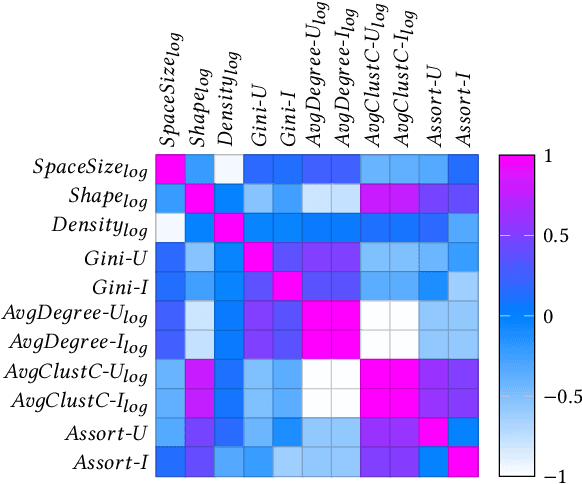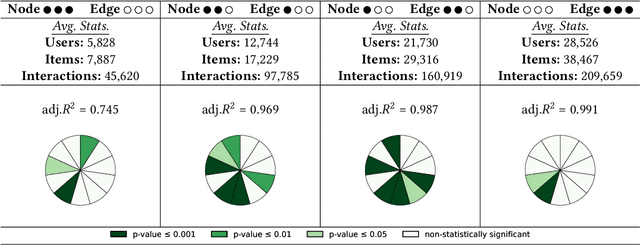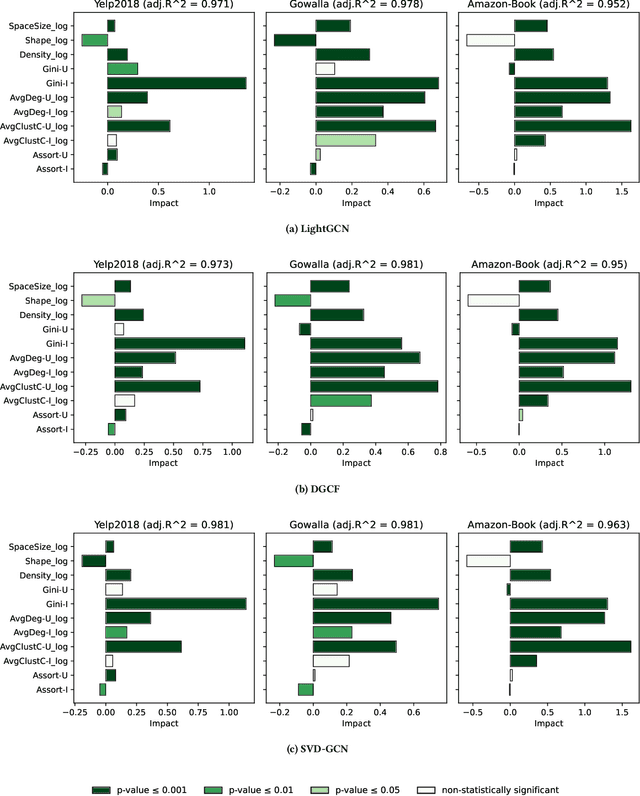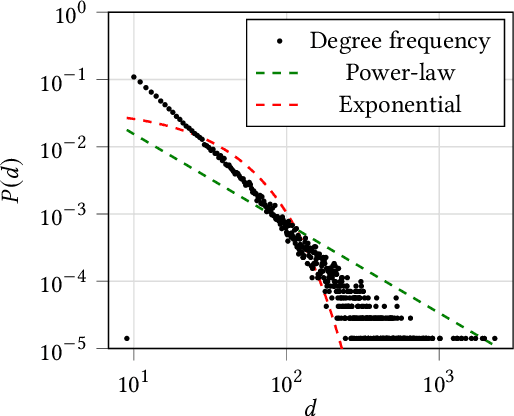Vito Walter Anelli
Balancing Accuracy and Novelty with Sub-Item Popularity
Aug 07, 2025Abstract:In the realm of music recommendation, sequential recommenders have shown promise in capturing the dynamic nature of music consumption. A key characteristic of this domain is repetitive listening, where users frequently replay familiar tracks. To capture these repetition patterns, recent research has introduced Personalised Popularity Scores (PPS), which quantify user-specific preferences based on historical frequency. While PPS enhances relevance in recommendation, it often reinforces already-known content, limiting the system's ability to surface novel or serendipitous items - key elements for fostering long-term user engagement and satisfaction. To address this limitation, we build upon RecJPQ, a Transformer-based framework initially developed to improve scalability in large-item catalogues through sub-item decomposition. We repurpose RecJPQ's sub-item architecture to model personalised popularity at a finer granularity. This allows us to capture shared repetition patterns across sub-embeddings - latent structures not accessible through item-level popularity alone. We propose a novel integration of sub-ID-level personalised popularity within the RecJPQ framework, enabling explicit control over the trade-off between accuracy and personalised novelty. Our sub-ID-level PPS method (sPPS) consistently outperforms item-level PPS by achieving significantly higher personalised novelty without compromising recommendation accuracy. Code and experiments are publicly available at https://github.com/sisinflab/Sub-id-Popularity.
Are the Hidden States Hiding Something? Testing the Limits of Factuality-Encoding Capabilities in LLMs
May 22, 2025Abstract:Factual hallucinations are a major challenge for Large Language Models (LLMs). They undermine reliability and user trust by generating inaccurate or fabricated content. Recent studies suggest that when generating false statements, the internal states of LLMs encode information about truthfulness. However, these studies often rely on synthetic datasets that lack realism, which limits generalization when evaluating the factual accuracy of text generated by the model itself. In this paper, we challenge the findings of previous work by investigating truthfulness encoding capabilities, leading to the generation of a more realistic and challenging dataset. Specifically, we extend previous work by introducing: (1) a strategy for sampling plausible true-false factoid sentences from tabular data and (2) a procedure for generating realistic, LLM-dependent true-false datasets from Question Answering collections. Our analysis of two open-source LLMs reveals that while the findings from previous studies are partially validated, generalization to LLM-generated datasets remains challenging. This study lays the groundwork for future research on factuality in LLMs and offers practical guidelines for more effective evaluation.
LLaMAs Have Feelings Too: Unveiling Sentiment and Emotion Representations in LLaMA Models Through Probing
May 22, 2025Abstract:Large Language Models (LLMs) have rapidly become central to NLP, demonstrating their ability to adapt to various tasks through prompting techniques, including sentiment analysis. However, we still have a limited understanding of how these models capture sentiment-related information. This study probes the hidden layers of Llama models to pinpoint where sentiment features are most represented and to assess how this affects sentiment analysis. Using probe classifiers, we analyze sentiment encoding across layers and scales, identifying the layers and pooling methods that best capture sentiment signals. Our results show that sentiment information is most concentrated in mid-layers for binary polarity tasks, with detection accuracy increasing up to 14% over prompting techniques. Additionally, we find that in decoder-only models, the last token is not consistently the most informative for sentiment encoding. Finally, this approach enables sentiment tasks to be performed with memory requirements reduced by an average of 57%. These insights contribute to a broader understanding of sentiment in LLMs, suggesting layer-specific probing as an effective approach for sentiment tasks beyond prompting, with potential to enhance model utility and reduce memory requirements.
Do LLMs Memorize Recommendation Datasets? A Preliminary Study on MovieLens-1M
May 15, 2025Abstract:Large Language Models (LLMs) have become increasingly central to recommendation scenarios due to their remarkable natural language understanding and generation capabilities. Although significant research has explored the use of LLMs for various recommendation tasks, little effort has been dedicated to verifying whether they have memorized public recommendation dataset as part of their training data. This is undesirable because memorization reduces the generalizability of research findings, as benchmarking on memorized datasets does not guarantee generalization to unseen datasets. Furthermore, memorization can amplify biases, for example, some popular items may be recommended more frequently than others. In this work, we investigate whether LLMs have memorized public recommendation datasets. Specifically, we examine two model families (GPT and Llama) across multiple sizes, focusing on one of the most widely used dataset in recommender systems: MovieLens-1M. First, we define dataset memorization as the extent to which item attributes, user profiles, and user-item interactions can be retrieved by prompting the LLMs. Second, we analyze the impact of memorization on recommendation performance. Lastly, we examine whether memorization varies across model families and model sizes. Our results reveal that all models exhibit some degree of memorization of MovieLens-1M, and that recommendation performance is related to the extent of memorization. We have made all the code publicly available at: https://github.com/sisinflab/LLM-MemoryInspector
Training-Free Consistency Pipeline for Fashion Repose
Jan 23, 2025



Abstract:Recent advancements in diffusion models have significantly broadened the possibilities for editing images of real-world objects. However, performing non-rigid transformations, such as changing the pose of objects or image-based conditioning, remains challenging. Maintaining object identity during these edits is difficult, and current methods often fall short of the precision needed for industrial applications, where consistency is critical. Additionally, fine-tuning diffusion models requires custom training data, which is not always accessible in real-world scenarios. This work introduces FashionRepose, a training-free pipeline for non-rigid pose editing specifically designed for the fashion industry. The approach integrates off-the-shelf models to adjust poses of long-sleeve garments, maintaining identity and branding attributes. FashionRepose uses a zero-shot approach to perform these edits in near real-time, eliminating the need for specialized training. consistent image editing. The solution holds potential for applications in the fashion industry and other fields demanding identity preservation in image editing.
Scalable Cloud-Native Pipeline for Efficient 3D Model Reconstruction from Monocular Smartphone Images
Sep 28, 2024Abstract:In recent years, 3D models have gained popularity in various fields, including entertainment, manufacturing, and simulation. However, manually creating these models can be a time-consuming and resource-intensive process, making it impractical for large-scale industrial applications. To address this issue, researchers are exploiting Artificial Intelligence and Machine Learning algorithms to automatically generate 3D models effortlessly. In this paper, we present a novel cloud-native pipeline that can automatically reconstruct 3D models from monocular 2D images captured using a smartphone camera. Our goal is to provide an efficient and easily-adoptable solution that meets the Industry 4.0 standards for creating a Digital Twin model, which could enhance personnel expertise through accelerated training. We leverage machine learning models developed by NVIDIA Research Labs alongside a custom-designed pose recorder with a unique pose compensation component based on the ARCore framework by Google. Our solution produces a reusable 3D model, with embedded materials and textures, exportable and customizable in any external 3D modelling software or 3D engine. Furthermore, the whole workflow is implemented by adopting the microservices architecture standard, enabling each component of the pipeline to operate as a standalone replaceable module.
Enhancing Sequential Music Recommendation with Personalized Popularity Awareness
Sep 06, 2024

Abstract:In the realm of music recommendation, sequential recommender systems have shown promise in capturing the dynamic nature of music consumption. Nevertheless, traditional Transformer-based models, such as SASRec and BERT4Rec, while effective, encounter challenges due to the unique characteristics of music listening habits. In fact, existing models struggle to create a coherent listening experience due to rapidly evolving preferences. Moreover, music consumption is characterized by a prevalence of repeated listening, i.e., users frequently return to their favourite tracks, an important signal that could be framed as individual or personalized popularity. This paper addresses these challenges by introducing a novel approach that incorporates personalized popularity information into sequential recommendation. By combining user-item popularity scores with model-generated scores, our method effectively balances the exploration of new music with the satisfaction of user preferences. Experimental results demonstrate that a Personalized Most Popular recommender, a method solely based on user-specific popularity, outperforms existing state-of-the-art models. Furthermore, augmenting Transformer-based models with personalized popularity awareness yields superior performance, showing improvements ranging from 25.2% to 69.8%. The code for this paper is available at https://github.com/sisinflab/personalized-popularity-awareness.
A Novel Evaluation Perspective on GNNs-based Recommender Systems through the Topology of the User-Item Graph
Aug 21, 2024



Abstract:Recently, graph neural networks (GNNs)-based recommender systems have encountered great success in recommendation. As the number of GNNs approaches rises, some works have started questioning the theoretical and empirical reasons behind their superior performance. Nevertheless, this investigation still disregards that GNNs treat the recommendation data as a topological graph structure. Building on this assumption, in this work, we provide a novel evaluation perspective on GNNs-based recommendation, which investigates the impact of the graph topology on the recommendation performance. To this end, we select some (topological) properties of the recommendation data and three GNNs-based recommender systems (i.e., LightGCN, DGCF, and SVD-GCN). Then, starting from three popular recommendation datasets (i.e., Yelp2018, Gowalla, and Amazon-Book) we sample them to obtain 1,800 size-reduced datasets that still resemble the original ones but can encompass a wider range of topological structures. We use this procedure to build a large pool of samples for which data characteristics and recommendation performance of the selected GNNs models are measured. Through an explanatory framework, we find strong correspondences between graph topology and GNNs performance, offering a novel evaluation perspective on these models.
Evaluating ChatGPT as a Recommender System: A Rigorous Approach
Sep 07, 2023



Abstract:Recent popularity surrounds large AI language models due to their impressive natural language capabilities. They contribute significantly to language-related tasks, including prompt-based learning, making them valuable for various specific tasks. This approach unlocks their full potential, enhancing precision and generalization. Research communities are actively exploring their applications, with ChatGPT receiving recognition. Despite extensive research on large language models, their potential in recommendation scenarios still needs to be explored. This study aims to fill this gap by investigating ChatGPT's capabilities as a zero-shot recommender system. Our goals include evaluating its ability to use user preferences for recommendations, reordering existing recommendation lists, leveraging information from similar users, and handling cold-start situations. We assess ChatGPT's performance through comprehensive experiments using three datasets (MovieLens Small, Last.FM, and Facebook Book). We compare ChatGPT's performance against standard recommendation algorithms and other large language models, such as GPT-3.5 and PaLM-2. To measure recommendation effectiveness, we employ widely-used evaluation metrics like Mean Average Precision (MAP), Recall, Precision, F1, normalized Discounted Cumulative Gain (nDCG), Item Coverage, Expected Popularity Complement (EPC), Average Coverage of Long Tail (ACLT), Average Recommendation Popularity (ARP), and Popularity-based Ranking-based Equal Opportunity (PopREO). Through thoroughly exploring ChatGPT's abilities in recommender systems, our study aims to contribute to the growing body of research on the versatility and potential applications of large language models. Our experiment code is available on the GitHub repository: https://github.com/sisinflab/Recommender-ChatGPT
A Topology-aware Analysis of Graph Collaborative Filtering
Aug 21, 2023Abstract:The successful integration of graph neural networks into recommender systems (RSs) has led to a novel paradigm in collaborative filtering (CF), graph collaborative filtering (graph CF). By representing user-item data as an undirected, bipartite graph, graph CF utilizes short- and long-range connections to extract collaborative signals that yield more accurate user preferences than traditional CF methods. Although the recent literature highlights the efficacy of various algorithmic strategies in graph CF, the impact of datasets and their topological features on recommendation performance is yet to be studied. To fill this gap, we propose a topology-aware analysis of graph CF. In this study, we (i) take some widely-adopted recommendation datasets and use them to generate a large set of synthetic sub-datasets through two state-of-the-art graph sampling methods, (ii) measure eleven of their classical and topological characteristics, and (iii) estimate the accuracy calculated on the generated sub-datasets considering four popular and recent graph-based RSs (i.e., LightGCN, DGCF, UltraGCN, and SVD-GCN). Finally, the investigation presents an explanatory framework that reveals the linear relationships between characteristics and accuracy measures. The results, statistically validated under different graph sampling settings, confirm the existence of solid dependencies between topological characteristics and accuracy in the graph-based recommendation, offering a new perspective on how to interpret graph CF.
 Add to Chrome
Add to Chrome Add to Firefox
Add to Firefox Add to Edge
Add to Edge